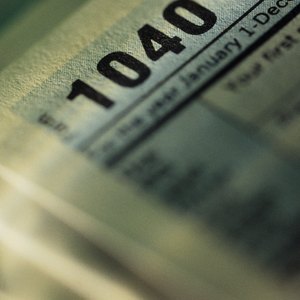
Proposed in the Wall Street Journal in 1981 by Robert Hall and Alan Rabushka as an alternative to the existing United States Tax Code, the flat tax is popular in some state capitals and the national governments of several foreign countries. This low, simple tax continues to be considered now and again as a means to simplify the U.S. Tax Code.
The recurring popularity of the flat tax is due, in part, to the fact it's said to be simple enough that an individual or business would file a tax return on a postcard-sized form – no flat tax calculator needed. While the flat tax continues to be discussed in Washington political circles, some politicians appear to believe the disadvantages of the flat tax outweigh its benefits.
Implementation of the Flat Tax
President Ronald Reagan's Tax Reform Act of 1986 was a result of the growing popularity of the idea of a flat tax. But the 1986 act led to two tax rates: 15 and 28 percent. Then, in 1990, President George W. Bush signed the Omnibus Budget Reconciliation Act, which introduced an additional 31 percent tax on "the rich." Then, in 1993, the Clinton administration added two additional brackets, 36 and 39.6 percent.
Flat Tax Rate Pros and Cons
In countries and states for which a flat tax has been imposed, each citizen is taxed at the same rate. Some countries that adopt the flat tax say the approach serves as an incentive to taxpayers to earn higher wages since ever-higher tax rates aren't imposed based on income.
What's more, the task of filing a tax return is simple for citizens of governments that impose a flat tax than for U.S. citizens who must deal with multiple rates, forms and so on. In addition, the countries who impose a flat tax on business may benefit through a resultant growth in the state and national economies in that the flat tax may attract business operations.
Also, a flat tax infers a sense of fairness to citizens and businesses alike due to the single tax rate. Consequently, the tax code prevents the allotment of special privileges to a person or entity for political reasons.
Advantages and Disadvantages of Flat Tax
When a flat tax is legislated, each person or entity pays the same rate. This approach penalizes or places an out-sized burden on middle- and low-income families. For instance, after a 20 percent flat tax is imposed, two individuals who earn $1 million and $50,000 respectively, will have an after-tax income of $800,000 and only $40,000. In addition, a flat tax does not result in the wealth redistribution, which can contribute to the attainment of a a certain standard of living for all members of a society.
Also, if a given business activity can be carried out in a country with a lower rate than that of another, the OECD Taxing Wages 2020 report says investors would be unwilling to bear the additional tax burden. Instead, a company would likely consider locating in the location with the lower rate.
Unfortunately, due to the effect of the tax rate on the seeming attractiveness of operating in a certain country, a flat tax is a means for one country to instigate a tax rate war with another country. When this occurs, each nation must decrease their tax rates, sometimes on a repeat basis, to compete. This process can lead to the fiscal instability of one or both countries.
Then again, a flat tax will apply one tax rate on each taxpayer's income and no deductions or exemptions are part of the tax code. As in the Bush and Clinton administrations, however, politicians may be tempted to impose additional rates. Politicians can also stipulate the retention of some deductions which belies the nature of the flat tax.
Finally, while a country may adopt a flat tax to contribute to efforts to build a booming economy, no direct relation has been proven to exist between this form of taxation and a growing and resilient economy.
References
Writer Bio
Billie Nordmeyer is an IT consultant of 25 years standing. As a senior technical consultant for SAP America and Deloitte Touche DRT Systems, a business analyst, senior staff, and independent consultant, Billie has worked across the retail, oil and gas, pharmaceutical, aeronautics and banking industries. Billie holds a BSBA accounting, MBA finance, MA international management as well as the Business Analyst and Software Project Management certificates from the Cockrell School of Engineering at the University of Texas at Austin.

